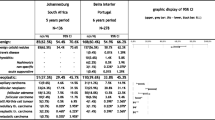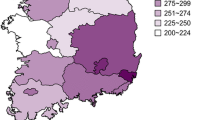Abstract
Background
The goal of eliminating iodine deficiency (ID) by the year 2000 has still not been achieved in several countries. More than 2 billion people worldwide (over 260 million school age children) remain ID. In Europe, there are still countries, such as Portugal, without national general population data on iodine nutrition (IN). This study aims at evaluating combined complementary data of the IN of the general population through urinary iodine concentration (UIC) and the thyroid histology profile from the inland region of Beira Interior (BI), in Portugal.
Methods
UIC from a population sample of 214 volunteers (131 females and 83 males), with ages ranging from 8 to 97 years (mean 51.5 years ± SD 20.74 years), from BI was determined; the thyroid histology pattern in BI (6-year period) was evaluated; and the iodine content of the largest surface water reservoir of BI, never previously reported, was measured.
Results
Median UIC of 62.6 μg/L was measured. Over 92 % of the population had UIC less than 100 μg/L. From 279 histology reports evaluated, the incidence of the different types of thyroid nodular pathology in BI was established. There were 60 histologic diagnoses of malignancy. The observed ratio of papillary to follicular carcinoma relatively close to 1 and the fairly high percentage of anaplastic carcinomas are characteristic of ID areas.
Conclusions
The findings of this first general population study on IN from the inland region of BI, Portugal, document significant ID. This problem, with its serious public health implications, could be corrected by having affordable iodised salt widely and generally available and by promoting a proactive population attitude generated by ample public information and educational programs as to the negative consequences of ID.


Similar content being viewed by others
Abbreviations
- ATC:
-
Anaplastic thyroid cancer
- BI:
-
Beira Interior
- CI:
-
Confidence interval
- H&E:
-
Hematoxilin and eosine
- FTC:
-
Follicular thyroid cancer
- IC:
-
Iodine content
- ID:
-
Iodine deficiency
- IDD:
-
Iodine deficiency disorders
- IN:
-
Iodine nutrition
- PF:
-
Papillary to follicular
- PTC:
-
Papillary thyroid cancer
- TC:
-
Thyroid cancer
- UIC:
-
Urinary iodine concentration
- UK:
-
United Kingdom
- USA:
-
United States of America
References
Hetzel BS (2007) Global progress in addressing iodine deficiency through USI: the makings of a global public health success story—the first decade (1985–1995). United Nations, Standing Committee on Nutrition 2007. www.unsystem.org/scn/Publications/SCNNews/scnnews35:5-11. Accessed 29 Mar 2014
Delange F, de Benoist B, Pretell E, Dunn JT (2001) Iodine deficiency in the world: where do we stand at the turn of the century? Thyroid 11:437–446
Hetzel BS (1983) Iodine deficiency disorders (IDD) and their eradication. Lancet 322:1126–1129
Vanderpump MPJ, Lazarus JH, Smyth PP, Laurberg P, Holder RL, Boelaert K, Franklyn JA, British Thyroid Association UK Iodine Survey Group (2011) Iodine status of UK schoolgirls: a cross-sectional survey. Lancet 377:2007–2012
de Benoist B, McLean E, Anderson M, Rogers L (2008) Iodine deficiency in 2007: global progress since 2003. Food Nutr Bull 29:195–202
Vitti P, Rago T, Aghini-Lombardi F, Pinchera A (2001) Iodine deficiency disorders in Europe. Public Health Nutr 4:529–535
Schneider AB, Brenner BM (2005) A carcinoma of follicular epithelium—epidemiology and pathogenesis. In: Braverman LE, Utiger RD (eds) Werner & Ingbar’s—the thyroid: a fundamental and clinical text, 9th edn. Lippincott Williams & Wilkins, Philadelphia, pp 889–906
Ruben Harach HRH (2009) Iodine deficiency and thyroid cancers: Effect of iodine prophylaxis on thyroid cancer morphology. In: Preedy VR, Burrow GN, Watson RR (eds) Comprehensive handbook of iodine. Academic Press, Elsevier, London, pp 513–519
Bacher-Stier C, Riccabona G, Totsch M, Kremmler G, Oberaigner W, Moncayo R (1997) Incidence and clinical characteristics of thyroid carcinoma after iodine prophylaxis in an endemic goitre country. Thyroid 7:733–741
Huszno B, Szybinski Z, Przybylik-Mazurek E, Stachura J, Trofimiuk M, Buziak-Bereza M, Golkowski F, Pantoflinski J (2003) Influence of iodine deficiency and iodine prophylaxis on thyroid cancer histotypes and incidence in endemic goiter area. J Endocrinol Invest 26:71–76
Soldin OP (2002) Controversies in urinary iodine determinations. Clin Biochem 35:575–579
Delange F (1994) The disorders induced by iodine deficiency. Thyroid 4:107–128
Johnson CC, Fordyce FM, Stewart AG. Environmental controls on iodine deficiency disorders. British Geological Survey International/Environment Protection Program. nora.nerc.ac.uk/8355/1/CR03058N.pdf. Accessed 29 Mar 2014
WHO global database on iodine deficiency. World Health Organization, Geneva, Switzerland. http://www.who.int/vmnis/database/iodine/en/. Accessed 4 Aug 2014
Anderson M, Karumbunathan V, Zimmermann MB (2012) Global iodine status in 2011 and trends over the past decade. J Nutr 142:744–750
Limbert E, Prazeres S, São Pedro M, Madureira D, Miranda A, Ribeiro M, Jacome de Castro J, Carrilho F, Oliveira MJ, Reguengo H, Borges F (2010) Iodine intake in Portuguese pregnant women: results of a countrywide study. Eur J Endocrinol 163:631–635
Census 2011. www.ine.pt. Accessed Sep 7 2015
Galopim de Carvalho AM. Geologia da Serra da Estrela 1999. www.prof2000.pt/users/geologia/geologia.htm. Accessed 4 Aug 2014
Sandell EB, Kolthoff M (1937) Micro determination of iodine by a catalytic method. Mikrochem Acta 1:9–25
Hedinger C, Williams ED, Sobin LH (1989) The WHO histological classification of thyroid tumours: commentary on the second edition. Cancer 63:908–911
Wang CCC, Friedman L, Kennedy GC, Wang H, Kebebew E, Steward DL, Zeiger MA, Westra WH, Wang Y, Khanafshar E, Fellegara G, Rosai J, LiVolsi V, Lanman B (2011) A large multicentre correlation study of thyroid nodule cytopathology and histopathology. Thyroid 21:243–251
Bland M (2000) An introduction to medical statistics, 3rd edn. Oxford University Press, Oxford
Thyroid Nodules and Goitre (2015) Endocrine facts and figures: thyroid, 1st edn. Endocrine Society
WHO/UNICEF/ICCIDD 2007 Assessment of iodine deficiency disorders and monitoring their elimination—a guide for program managers, 3rd edn. WHO, Geneva, WHO/NHD 1-97. whqlibdoc.who.int/…/9789241595827_eng.pdf. Accessed Sep 1 2015
Zimmermann MB, Boelaert K (2015) Iodine deficiency and thyroid disorders. Lancet Diabetes Endocrinol 3:286–295. www.thelancet.com/diabetes-endocrinology January 13, 2015. Accessed Sep 9 2015
Santiago-Fernandez P, Torres-Barahona R, Muela-Martinez A, Rojo-Martinez G, Garcia-Fuentes E, Jose Garriga M, Garcia Leon A, Soriguer F (2004) Intelligence quotient and iodine intake: a cross-sectional study in children. J Clin Endocrinol Metab 89:3851–3857
Bleichrodt N, Born MP (1994) A metaanalysis of research on iodine and its relationship to cognitive development. In: Stanbury JB (ed) The damaged brain of iodine deficiency. Cognizant Communication, New York, pp 195–200
Dunn JT, Delange F (2001) Damaged reproduction: the most important consequence of iodine deficiency. J Clin Endocrinol Metab 86:2360–2363
Belfiore A, La Rosa GL, Ippolito O, Padova G, Sava L, Vigneri R (1987) The frequency of cold thyroid nodules and thyroid malignancies in patients from an iodine deficient area. Cancer 60:3096–3102
Zimmermann MB, Galetti V (2015) Iodine intake as a risk factor for thyroid cancer: a comprehensive review of animal and human studies. Thyroid Res 8:1–21. http://www.thyroidresearchjournal.com/content/8/1/8. Accessed Sep 09 2015
Lind P, Langersteger W, Molnar M, Gallowitsch HJ, Mikosch P, Gomez I (1998) Epidemiology of thyroid diseases in iodine sufficiency. Thyroid 8:1179–1183
Wang J, Harris M, Amos B, Li M, Wang X, Zhang J, Chen J (1997) A ten year review of the iodine deficiency disorders program of the People’s Republic of China. J Public Health Policy 18:219–241
Codling K, Chen Z, Hongmei S, Li M, GuY, Lu ZX, Suying C (2014) China: leading the way in sustained IDD elimination. International Council for Control of Iodine Deficiency Disorders (ICCIDD) Global Network. IDD Newsl 42(2):1–5
Jooste PL, Labadarios D, Nel H, Strydom E, National Food Consumption Survey-Fortification Baseline (NFCS-FB): South Africa (2005) Iodine content of household salt, drinking water and iodine status of women and children. Stellenbosh S Afr 2007:387–407
Kalk WJ (1998) Iodine deficiency disorders in South Africa. S Afr Med J 88:352–354
Assessment of iodine deficiency disorders and monitoring their elimination. A guide for program managers. WHO/UNICEF/ICCIDD 2001. http://www.who.int/nutrition/publications/micronutrients/iodine_deficiency/WHO_NHD_01.1/en. Accessed 07 Sep 2015
Andersson M, de Benoist B, Darnton-Hill I, Delange F (2007) Iodine deficiency in Europe: a continuing public health problem. World Health Organization, Geneva. ISBN 978 92 4 159396 0 www.who.int/nutrition/publications/VMNIS_Iodine_deficiency_in_Europe. Accessed 07 Sep 2015
Acknowledgments
The authors are grateful for the collaboration from the Portuguese Oncology Institutes of Coimbra, Oporto and Lisbon for providing all data relating to patients with thyroid nodular pathology with a residential address from the area of Beira Interior. We are grateful for the assistance of Dr. Helena Garcia of Cedap with re-evaluating some of the histologies and the clarification of their diagnoses. The authors are grateful to Águas da Covilhã for facilitating the collection of the water samples for analysis.
Authors’ contributions
JECS contributed to the design of the study, the major writing of the manuscript as well as the acquisition of most of the data; he coordinated the statistical design and the data interpretation. JLR contributed to the writing of the manuscript, the sequence alignment, as well as to its critical revision and correction. MF contributed to the elaboration and writing of the statistical analysis, as well as to the elaboration and design of table and figures, and participated in the sequence alignment critical revision and correction of the manuscript. CPF designed, performed and supervised the laboratory evaluation of urinary iodine concentration (UIC) and the iodine measurement in local water reservoir, as well as writing the sections relating to this part of the manuscript. PC performed most of the laboratory evaluation of the UIC. IMC contributed to the sequence alignment, critical revision and correction of the manuscript. MCB participated in the overall supervision and critical evaluation of the study, as well as the critical revision and correction of the study. All authors have read and approved the final manuscript.
Author information
Authors and Affiliations
Corresponding author
Ethics declarations
Conflict of interest
The authors declare that no competing financial interests exist.
Ethical approval
This study was approved by the ethics committees of the Faculty of Health Sciences of the University of Beira Interior and of Centro Hospitalar Cova da Beira (Hospitals of Covilhã and Fundão), research involving human participants being performed in accordance with ethical standards as laid down in the 1964 Declaration of Helsinki, its later amendments or comparable ethical standards.
Informed consent
Informed consent was obtained from all individual participants included in the study.
Rights and permissions
About this article
Cite this article
Santos, J.E.C., Freitas, M., Fonseca, C.P. et al. Iodine deficiency a persisting problem: assessment of iodine nutrition and evaluation of thyroid nodular pathology in Portugal. J Endocrinol Invest 40, 185–191 (2017). https://doi.org/10.1007/s40618-016-0545-2
Received:
Accepted:
Published:
Issue Date:
DOI: https://doi.org/10.1007/s40618-016-0545-2




